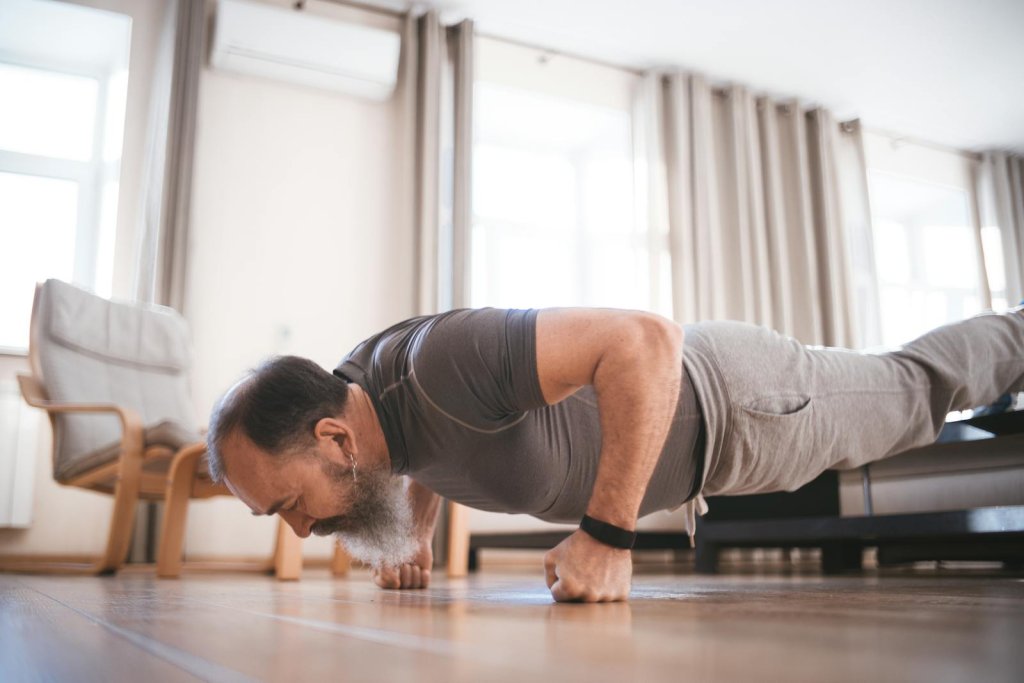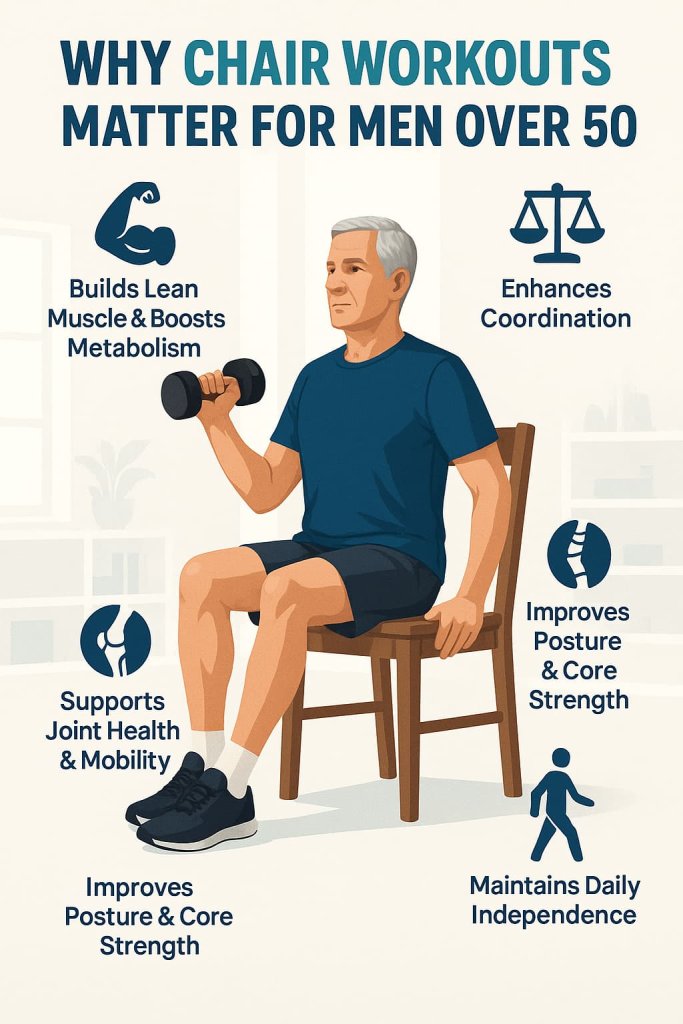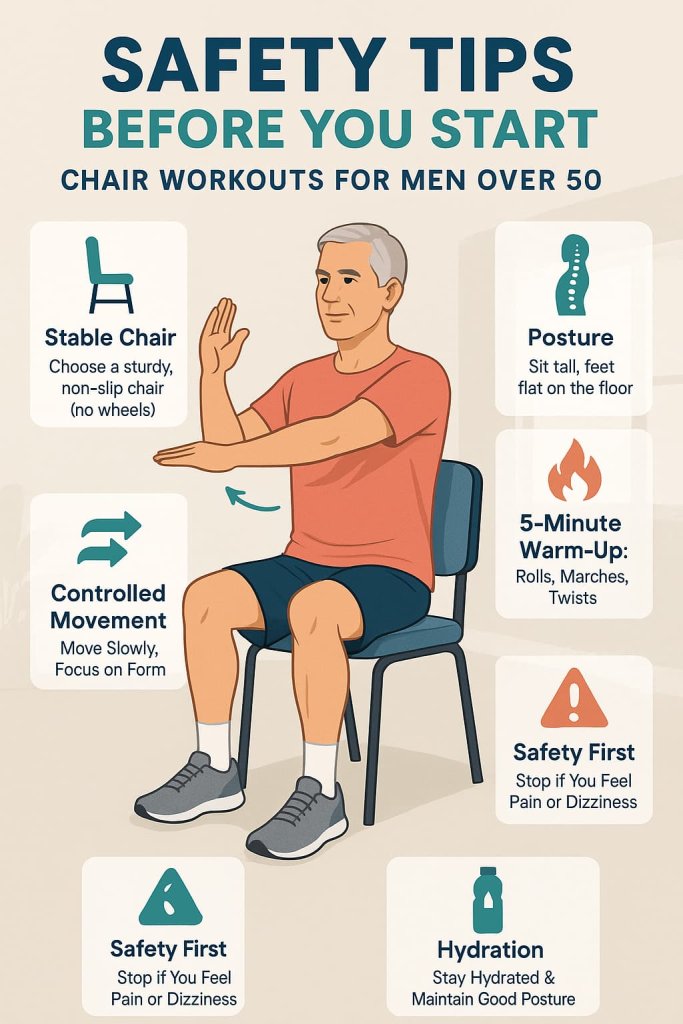Staying strong after 50 doesn’t require fancy equipment or long gym sessions — you can build strength, stability, and stamina right from a chair. Chair workouts are safe, low-impact, and ideal for men managing joint stiffness, balance issues, or recovering from injury.

These exercises improve muscle tone, mobility, and circulation without stressing the knees or back. According to Experts, chair exercises boost strength, flexibility, and endurance for adults over 50 while reducing injury risk and improving daily functional movement.
Why Chair Workouts Matter for Men Over 50
As we age, muscle mass naturally declines — a condition known as sarcopenia. By 50, men can lose up to 1–2% of muscle mass annually if inactive (NIH, 2024). Chair workouts combat this decline safely.

Benefits include:
- Builds lean muscle and boosts metabolism
- Enhances balance and coordination
- Supports joint health and flexibility
- Improves posture and core stability
- Helps maintain independence and mobility
Safety Tips Before You Start

- Choose a sturdy, non-slip chair (no wheels or arms).
- Sit upright with feet flat on the floor.
- Warm up 5 minutes with shoulder rolls, marching, or gentle twists.
- Move slowly and focus on form over speed.
- Stop if you feel pain or dizziness.
- Breathe naturally — exhale on exertion, inhale on release.
Trainer Tip: Keep a bottle of water handy and maintain good posture throughout every move.
12 Best Chair Workouts for Men Over 50
These 12 chair workouts are designed to help men over 50 build strength, improve mobility, and stay active safely at home. Each move targets key muscles for better balance, posture, and overall fitness.
1. Seated March
Why it works:
Improves hip mobility, boosts circulation, and activates your core and lower body — perfect for warming up or maintaining joint flexibility.
Muscles worked:
Hip flexors, quadriceps, lower abs, and glutes.
How to do it:
- Sit tall with your back straight and feet flat on the floor.
- Lift one knee toward your chest, then lower it back down.
- Alternate legs as if you’re marching in place.
- Continue for 45–60 seconds at a controlled pace.
Trainer Tip:
Keep your abs engaged to support your lower back and prevent slouching.
2. Seated Arm Circles
Why it works:
Enhances shoulder mobility and builds endurance in the deltoids and upper arms, improving range of motion and joint stability.
Muscles worked:
Deltoids, trapezius, and upper arms.
How to do it:
- Sit tall and extend your arms to the sides at shoulder height.
- Make small circles forward for 30 seconds, then reverse for 30 seconds.
- Keep your neck relaxed and shoulders down.
Trainer Tip:
Add light dumbbells or resistance bands for a greater challenge.
3. Chair Squats
Why it works:
Develops lower-body strength for daily movements like sitting, standing, and climbing stairs.
Muscles worked:
Quadriceps, glutes, hamstrings, and core.
How to do it:
- Sit at the edge of a sturdy chair with feet hip-width apart.
- Lean slightly forward and press through your heels to stand up.
- Slowly lower yourself back down until your thighs touch the chair.
- Repeat 10–12 times.
Trainer Tip:
Keep your chest lifted and knees aligned with your toes. Use your arms only if you need extra support.
4. Seated Shoulder Press
Why it works:
Strengthens the shoulders and upper arms, improving functional strength for lifting and reaching.
Muscles worked:
Deltoids, triceps, and upper chest.
How to do it:
- Hold dumbbells (or water bottles) at shoulder level, palms facing forward.
- Press the weights overhead until your arms are straight.
- Lower slowly to the start position.
- Perform 10–15 reps.
Trainer Tip:
Keep your abs tight and avoid arching your lower back during the press.
5. Seated Leg Extensions
Why it works:
Targets and strengthens your quadriceps while improving knee stability and mobility.
Muscles worked:
Quadriceps, hip flexors.
How to do it:
- Sit tall with your knees bent and feet flat on the ground.
- Extend one leg until it’s straight out in front of you.
- Hold for 2–3 seconds, then lower slowly.
- Alternate legs for 10–12 reps per side.
Trainer Tip:
Add ankle weights or resistance bands once you can complete 15 reps easily.
6. Seated Side Bends
Why it works:
Improves flexibility, strengthens obliques, and supports spinal mobility — key for preventing lower back stiffness.
Muscles worked:
Obliques, lower back, and core stabilizers.
How to do it:
- Sit upright with hands behind your head or across your chest.
- Slowly bend to the right side, return to center, then bend to the left.
- Move smoothly and avoid jerking.
- Perform 10–15 reps each side.
Trainer Tip:
Keep your hips square and avoid twisting — focus on side flexion only.
7. Seated Bicep Curls
Why it works:
Builds arm strength and tones the biceps, making everyday lifting easier.
Muscles worked:
Biceps brachii and forearms.
How to do it:
- Hold dumbbells with palms facing upward and elbows close to your torso.
- Curl the weights toward your shoulders, then lower slowly.
- Repeat 10–15 times.
Trainer Tip:
Move slowly to maximize muscle tension — avoid swinging or using momentum.
8. Seated Toe Taps
Why it works:
Boosts blood circulation, ankle mobility, and lower-leg endurance.
Muscles worked:
Tibialis anterior, calves, and hip flexors.
How to do it:
- Sit tall and keep your heels on the floor.
- Rapidly lift and lower your toes for 30–60 seconds.
- Keep a steady rhythm and breathe naturally.
Trainer Tip:
Vary your pace — alternate 20 seconds slow, 20 fast — to improve coordination.
9. Seated Triceps Dips (Chair-Assisted)
Why it works:
Targets the triceps and strengthens the back of the arms, reducing flabbiness.
Muscles worked:
Triceps, shoulders, and chest.
How to do it:
- Sit on the edge of a stable chair, hands beside your hips.
- Slide forward until your hips are off the seat.
- Bend elbows to 90°, then push yourself back up.
- Perform 8–12 reps.
Trainer Tip:
Keep your back close to the chair and elbows pointing straight back, not flared.
10. Seated Torso Twists
Why it works:
Strengthens your core and improves spinal rotation for better flexibility and posture.
Muscles worked:
Obliques, transverse abdominis, and lower back.
How to do it:
- Sit tall with feet flat and arms crossed over your chest.
- Twist your torso to one side, then to the other, keeping hips stable.
- Perform 10–15 twists per side.
Trainer Tip:
Focus on controlled movement — don’t rush or use momentum.
11. Seated Calf Raises
Why it works:
Improves lower-leg strength and circulation, which supports walking and balance.
Muscles worked:
Gastrocnemius and soleus (calves).
How to do it:
- Sit tall with feet flat and knees at 90 degrees.
- Lift your heels as high as possible, pause, and lower slowly.
- Do 15–20 reps.
Trainer Tip:
For added challenge, rest a dumbbell or book on your thighs.
12. Seated Kickbacks
Why it works:
Activates the glutes and hamstrings, enhancing stability and stride power when walking.
Muscles worked:
Glutes, hamstrings, and core.
How to do it:
- Sit tall with knees bent and feet flat.
- Extend one leg back behind you, squeezing your glutes.
- Return slowly and switch sides.
- Perform 10–12 reps per leg.
Trainer Tip:
Keep your chest lifted — avoid leaning forward or rounding your back.
Sample Weekly Chair Workout Plan
| Day | Focus | Duration |
|---|---|---|
| Monday | Full Body (1–12 moves) | 30–40 mins |
| Wednesday | Strength (1, 3, 4, 5, 7, 9) | 25–30 mins |
| Friday | Mobility & Core (2, 6, 8, 10, 11) | 25–35 mins |
| Sunday | Light Recovery Stretching | 20 mins |
Progression Tip: Add resistance bands or dumbbells as your strength improves. Increase reps gradually every 2–3 weeks.
Nutrition Tip for Men Over 50
Fuel your workouts with protein-rich foods like eggs, chicken, fish, and lentils. Aim for 1.6–2.0 g of protein per kilogram of body weight daily. Stay hydrated and include omega-3 fats (salmon, flaxseed) to reduce inflammation and support joint health.
FAQs About Chair Workouts for Men Over 50
1. Can I build real muscle with chair exercises?
Yes. Studies show that resistance-based chair workouts improve muscle strength and endurance, especially for beginners or older adults.
2. How often should I do chair workouts?
Aim for 3–4 times a week with at least one rest day between sessions.
3. Do I need equipment?
No, but light dumbbells or resistance bands can enhance results.
4. Are chair workouts safe for men with arthritis or back pain?
Yes — they are joint-friendly and reduce load on knees and spine. Always consult your doctor before starting.
5. How long until I see results?
Most people notice improved strength, posture, and energy within 4–6 weeks of consistent training.
6. Can these workouts help with weight loss?
Yes, when paired with a healthy diet and consistent movement.
7. What type of chair is best?
Use a stable, non-rolling chair with a flat seat and no arms.
Conclusion
Chair workouts offer a safe, effective way for men over 50 to regain strength, stability, and confidence — all from the comfort of home. Start small, stay consistent, and focus on good form. Over time, these exercises will improve your posture, balance, and energy — helping you stay strong and active for life.
Ready to get started?
Grab a sturdy chair and commit to your first 20-minute session today.
References
- NHS — Sitting exercises — step-by-step seated movements and safety notes from the UK’s public health service. https://www.nhs.uk/live-well/exercise/sitting-exercises/.
- NIA (NIH) — How can strength training build healthier bodies as we age? — evidence-based overview on resistance training benefits for older adults. https://www.nia.nih.gov/news/how-can-strength-training-build-healthier-bodies-we-age.
- U.S. HHS — Physical Activity Guidelines for Americans, 2nd Edition — official recommendations (includes muscle-strengthening and balance work for older adults). https://odphp.health.gov/healthypeople/tools-action/browse-evidence-based-resources/physical-activity-guidelines-americans-2nd-edition.
- Systematic Review — The Effect of Chair-Based Exercise on Physical Function in Older Adults (2021) — peer-reviewed synthesis showing benefits of chair programs. https://pmc.ncbi.nlm.nih.gov/articles/PMC7920319/.
